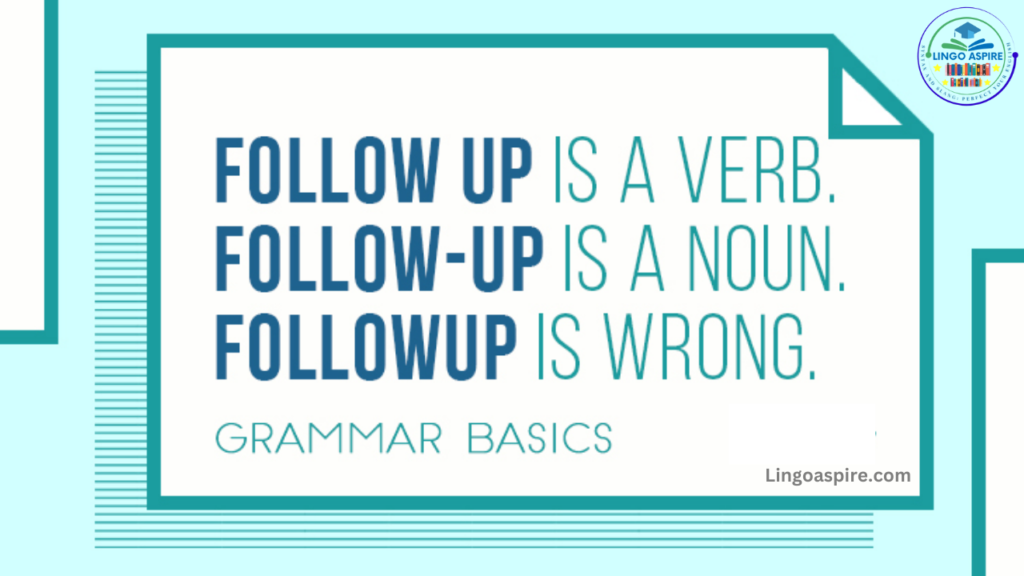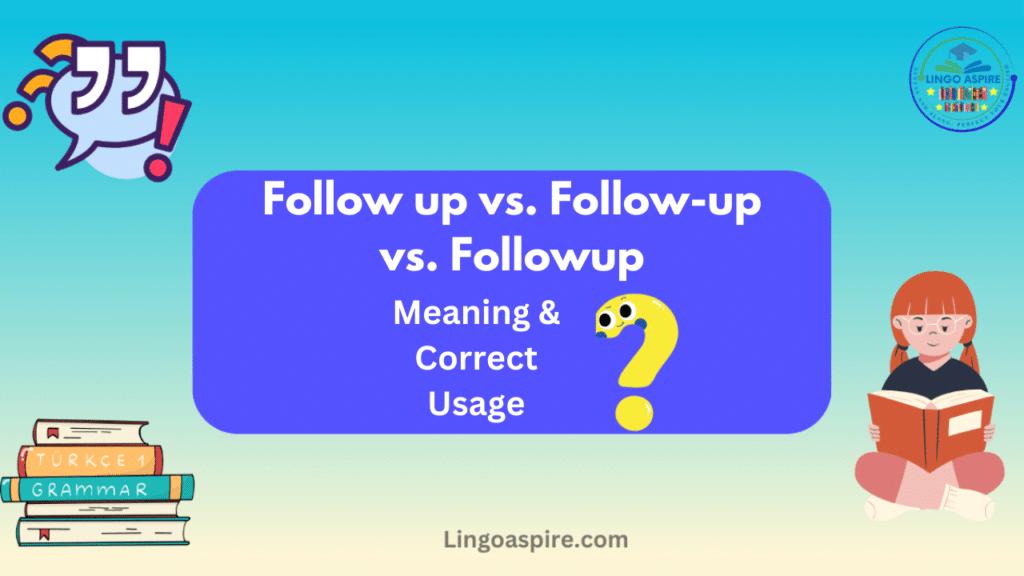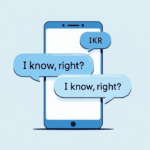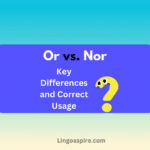Many people get confused about whether to use Follow Up vs. Follow-Up vs. Followup in writing. The difference might seem small, but using the right form matters, especially in professional settings. Follow-up grammar rules ensure clarity in emails, letters, business communication, and daily conversations. Whether you are writing a follow up email, a business follow-up, or a follow-up request, knowing when to use each form can improve your communication skills.
This guide explains the follow up definition, its grammatical uses, and how to apply it correctly in different situations. By the end, you will understand the correct use of follow up and learn the best follow-up practices for work, emails, and professional interactions.
Follow Up vs. Follow-Up vs. Followup – Key Differences

The main difference between these three forms lies in their grammatical roles. Understanding follow up meaning helps you avoid mistakes when using it in sentences.
| Term | Part of Speech | Example | Correct Usage |
|---|---|---|---|
| Follow up | Verb | “I will follow up on the report.” | Action |
| Follow-up | Noun / Adjective | “She scheduled a follow-up appointment.” | Thing or Description |
| Followup | Informal | “Let’s discuss the followup later.” | Rarely Used (Incorrect in formal writing) |
A follow-up example would be when a doctor schedules a follow-up appointment. Meanwhile, if you check on a client after a meeting, you are following up on the discussion. The form followup is mostly avoided in formal writing.
When to Use “Follow Up” (Verb Form)
The verb follow up means taking action after an initial contact or discussion. It is commonly used in professional emails, sales communication, and customer service. Knowing when to use follow up ensures that messages are clear and professional.
A follow up example in a sentence:
- “I will follow up with the client tomorrow.”
- “Please follow up on progress with the project team.”
- “Can you follow up after the meeting to confirm details?”
Best Practices for “Follow Up” in Business Communication
A proper business follow-up can improve relationships and ensure clarity. Here are some best follow-up practices:
- Be timely: Send a follow up email or make a follow up call within 24-48 hours.
- Be clear: State the purpose and expected response.
- Be professional: Keep the tone polite and respectful.
When to Use “Follow-Up” (Noun & Adjective)
The hyphenated form follow-up acts as a noun or adjective. It refers to an action or item that follows an initial interaction.
Examples of follow-up usage:
- “She scheduled a follow-up call with the client.”
- “The doctor’s follow-up appointment is next week.”
- “He sent a follow-up letter to confirm the request.”
Follow-Up in Different Business Situations
| Scenario | Follow-Up Example |
|---|---|
| After a meeting | “A follow-up request was sent to clarify points.” |
| Sales interaction | “The salesperson made a follow-up call.” |
| Interview process | “A candidate should send a follow-up email after an interview.” |
A strong follow-up strategy ensures effective communication. A proper follow-up can make a huge difference in business and personal interactions.
Is “Followup” a Real Word?
The word followup is sometimes seen in informal writing but is not widely accepted in standard English. Most grammar guides consider it incorrect. If you want to be professional, avoid using “followup” and stick to “follow up” (verb) or “follow-up” (noun/adjective).
Synonyms for “Follow Up” and “Follow-Up”

| Aspect | Follow Up (Verb) | Follow-Up (Noun/Adjective) |
|---|---|---|
| Definition | To take further action or check on something. | A second meeting, action, or review after the first. |
| Usage Type | Verb (Action) | Noun/Adjective (Thing or Description) |
| Example Sentence | “I will follow up with the client tomorrow.” | “The doctor scheduled a follow-up appointment.” |
| Hyphenation | No hyphen (two words). | Hyphen required. |
| Common Contexts | Emails, phone calls, inquiries, checking progress. | Medical visits, business meetings, reports. |
| Alternative Words | Check on, pursue, reconnect. | Review, reminder, evaluation. |
| Formal vs. Informal | Used in both formal and informal writing. | More common in formal contexts. |
| Grammatical Role | Verb phrase. | Noun or adjective. |
| Plural Form | No plural form (verbs don’t have plurals). | Plural: Follow-ups (for nouns). |
| Common Mistakes | Writing it as one word (followup). | Forgetting the hyphen (e.g., “follow up meeting” instead of “follow-up meeting”). |
| Business Usage | “Please follow up on the client’s request.” | “We need a follow-up discussion on the project.” |
| Email Subject Example | “Following up on our conversation.” | “Schedule a follow-up meeting.” |
Follow Up vs. Follow-Up in Emails
Writing a follow up email requires clarity and structure. Whether it’s a follow-up request or a business follow-up, the goal is to reinforce communication effectively.
How to Follow Up in Emails
- Use a clear subject line: “Follow-Up on Our Meeting” or “Follow Up Regarding Proposal.”
- Be concise and specific: Mention the topic and the next steps.
- Keep a professional tone: Avoid being too pushy.
Example of a Follow-Up Email:
Subject: Follow-Up on Our Discussion
Dear [Recipient],
I am following up on our meeting last week regarding the project timeline. Please let me know if you need any additional information. Looking forward to your response.
Best,
[Your Name]
This ensures follow-up communication remains polite and to the point.
Usage of “Follow Up” vs. “Follow-Up”

The difference between “follow up” (verb) and “follow-up” (noun/adjective) is important for proper grammar and communication. Below is a detailed explanation of how to use each form correctly in sentences.
1. “Follow Up” as a Verb
Definition: “Follow up” is a phrasal verb, meaning to take further action or check on something after an initial interaction.
Grammar Rule: Since it’s a verb, it can change tense (followed up, following up) and be used with auxiliary verbs.
Examples of “Follow Up” in Sentences:
- I will follow up with the client tomorrow.
- She followed up after the interview.
- He is following up on the customer complaint.
- Could you follow up with the supplier about the delay?
✅ Tip: “Follow up” is always two separate words when used as a verb.
2. “Follow-Up” as a Noun
Definition: “Follow-up” as a noun refers to a second meeting, call, email, or any action taken after an initial step.
Grammar Rule: It is always written with a hyphen (-) and can take a plural form (follow-ups).
Examples of “Follow-Up” in Sentences:
- The doctor scheduled a follow-up appointment next week.
- We need a follow-up on last week’s project discussion.
- The client requested a follow-up call to discuss pricing.
- Did you receive my follow-up email?
✅ Tip: If you can replace “follow-up” with “review” or “check-in,” then it’s being used as a noun.
3. “Follow-Up” as an Adjective
Definition: When used as an adjective, “follow-up” describes something related to the continuation of an action.
Grammar Rule: It is always hyphenated when used before a noun.
Examples of “Follow-Up” as an Adjective:
- He sent a follow-up email after the meeting.
- We scheduled a follow-up call with the client.
- The follow-up discussion will cover any unresolved issues.
- A follow-up survey was sent to customers.
✅ Tip: If “follow-up” comes before a noun and describes it, it’s an adjective.
Common Mistakes and How to Avoid Them

| Incorrect Usage | Correct Usage | Explanation |
|---|---|---|
| “I will follow-up with you later.” | “I will follow up with you later.” | The verb “follow up” should not have a hyphen. |
| “Let’s schedule a follow up meeting.” | “Let’s schedule a follow-up meeting.” | “Follow-up” is an adjective, so it needs a hyphen. |
| “She sent me a followup email.” | “She sent me a follow-up email.” | “Follow-up” is always hyphenated when used as a noun or adjective. |
Easy Trick to Remember the Difference
A simple rule for follow up vs follow-up is:
- If it’s an action, use “follow up” (two words).
- If it’s a thing or description, use “follow-up” (hyphenated).
This trick will help you follow up correctly in writing.
Frequently asked questions (FAQs) about follow up, follow-up, and followup:
1. What is the difference between follow up, follow-up, and followup?
The term follow up (two words) is a phrasal verb meaning to take further action or check on something later. Example: I will follow up on the report tomorrow.
The hyphenated version, follow-up, is a noun or adjective that refers to something that happens afterward, such as a meeting, call, or action. Example: We scheduled a follow-up meeting for next week.
The one-word version, followup, is considered incorrect in formal writing, though it is sometimes seen in informal contexts.
2. When should I use “follow up” in a sentence?
Use follow up as a verb when describing an action of checking back or taking further steps. Example: She will follow up with the client after the presentation.
3. How do I write a professional follow-up email?
A professional follow-up email should be clear, polite, and to the point. Start with a friendly greeting, remind the recipient of the previous conversation, state the purpose of your follow-up, and provide any necessary details. End with a polite closing, such as Looking forward to your response.
Final Thoughts & Quick Recap
Understanding follow up meaning and when to follow up can improve communication in professional settings. Use follow up as a verb, follow-up as a noun or adjective, and avoid “followup” in formal writing.
Key Takeaways:
- “Follow up” is a verb used in actions like emails or calls.
- “Follow-up” is a noun or adjective used for scheduled meetings or calls.
- “Followup” is rarely correct in professional writing.
- Best follow-up practices include being timely, professional, and clear.
- A follow-up strategy helps maintain business relationships.
Using the correct use of follow up makes your communication more effective. Whether sending a follow-up request, making a follow up call, or writing a follow-up letter, applying these rules will ensure clarity and professionalism.
Sources
- Merriam-Webster Dictionary – Provides definitions and examples of follow up (verb) and follow-up (noun/adjective).
- Grammarly Blog – Explains the grammatical differences between follow up and follow-up, including common mistakes and tips for proper usage.
- Cambridge Dictionary – Defines follow up and follow-up with real-world examples and explanations of when to use each form.







